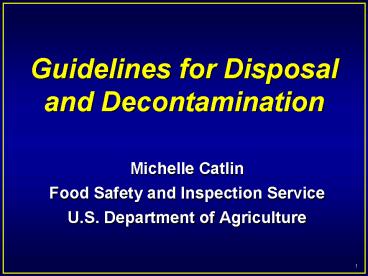Guidelines for Disposal and Decontamination - PowerPoint PPT Presentation
1 / 10
Title:
Guidelines for Disposal and Decontamination
Description:
identification of disposal facility willing to accept waste ... Secondary wastes from decontamination need to be disposed of appropriately ... – PowerPoint PPT presentation
Number of Views:42
Avg rating:3.0/5.0
Title: Guidelines for Disposal and Decontamination
1
Guidelines for Disposal and Decontamination
- Michelle Catlin
- Food Safety and Inspection Service
- U.S. Department of Agriculture
2
Federal Government Actions
- EPA coordinating (FDA, APHIS and FSIS)
development of Concept of Operations (CONOPS) - lays out roles and responsibilities for
decontamination and disposal response actions
under Homeland Security Presidential Directive 9
(HSPD-9) - addresses disposal and decontamination issues for
food products, live animals and crop materials - FSIS coordinating (FDA and EPA) development of
guidelines for field staff on disposal and
decontamination options - discusses disposal of food products and
decontamination of food processing facilities
only - discusses disposal and decontamination
options/techniques - discusses data gaps and capability needs
3
Special Considerations for Intentional
Contamination
- Type of agent might differ from an unintentional
contamination incident - Scale of incident might be greater (e.g., might
involve coordinated attacks on a number of
facilities) - Crime Scene coordination with local law
enforcement and FBI - Elevated pubic concern and interest
4
Discovery and Response
Threat received by FBI, local law enforcement,
other government agency, or facility owner
Surveillance/ monitoring systems suggest cluster
of food-borne disease or product contamination
Potential Intentional Adulteration Event Detected
- Where appropriate,
- Notify local law enforcement and/or the FBI
- Notify FSIS, FDA District Manager/Headquarters,
and USDA Headquarters - Notify establishment owner
- Notify State Dept of Health
Establish response team and identify commander
- Conduct investigation
- Detain/retain product
- Recall products, as needed
Clearance for disposal of contaminated food
products and decontamination of equipment and
facility obtained from incident commander
5
Disposal clearance obtained from incident
commander
Facility owner and FSIS inspector works with
State solid waste contact and waste facility to
coordinate disposal and obtain necessary permits
or permit modifications
- Contaminated facility owner works with FSIS and
other state and local authorities to come up with
disposal plan - Disposal plan should include
- different disposal options and which option
proposed - identification of disposal facility willing to
accept waste - contingency plan in case disposal capacity
saturated (additional disposal sites, methods,
etc.) - Submit plan to response team for review and
approval
Yes
No
Facility owner procures necessary transportation
for transferring contaminated products from site
to final disposal facility
Facility packages contaminated waste for transfer
- Transfer waste to disposal site
- Dispose of waste as planned
- FSIS inspectors oversee disposal process to
ensure contaminated product cannot get back into
food supply - State and local EPA officials oversee disposal
process to ensure contamination does not spread
to other media
Incident commander declares disposal action is
complete
Yes
No
6
Adulterated product removed from area incident
commander clears equipment and facilities for
decontamination
Is full decontamination economically feasible?
- Select method(s) of dismantling, decontamination,
and disposal
- Owner works with FSIS and state and local
authorities to develop decontamination plan - Submit decontamination plan to response team for
review/ approval
Yes
No
Owner obtains necessary permits for
decontamination process (e.g., permit for EPA
Crisis Exemption)
Is/are selected method(s) acceptable?
No
Yes
No
- FSIS inspectors oversee process to ensure
facility and equipment can be reintegrated into
food services - State and local EPA officials oversee
decontamination process to ensure contamination
is completely removed and secondary wastes are
disposed of properly
Owner procures decontamination services and
decontaminates equipment and facilities as planned
Yes
Post decontamination sampling to confirm
decontamination successful
Incident commander declares decontamination
action complete
No
Yes
7
Available Techniques - Disposal
- Rendering purified fat and protein components
recovered from inedible portions by
high-temperature cooking and separation
techniques - Can result in edible or inedible products
- Non-hazardous waste disposal
- Land disposal (municipal solid waste landfills)
- Combustion techniques (municipal or
commercial/industrial incinerators) - Hazardous waste disposal
- Land disposal (hazardous waste landfills)
- Combustion techniques (hazardous waste
incinerators) - Special handling
- Medical waste incinerators
- Radioactive waste disposal
- Low level radioactive waste
8
Available Techniques - Decontamination
- Decontamination technique dependent upon
- Contaminant
- Bacteria
- Spores
- Viruses and Parasites
- Toxins
- Chemicals (e.g., pesticides)
- Radiological Agents
- Surface
- Hard surface
- Facilities and structures
9
Response Needs
- Coordination among agencies and other
stakeholders - Temporary storage of contaminated product pending
decisions about disposal options - Limited capacity of local and regional disposal
resources/surge capacity exceeded - Analytical laboratory capabilities (helped by
FERN) - Ability to detect some agents in various food
matrices - Recall capabilities product being recalled might
be hazardous - Decontamination techniques not available for all
agents - Indemnification might be needed for
decontamination contractors (e.g., anthrax)
10
Other Issues
- Facility management/owner responsible for
disposal and decontamination - Need to work with EPA (or local/regional
equivalent) for disposal permits and any
necessary waivers for chemicals - Decontamination is too expensive
- Facility a crime scene product might be
evidence need to balance public health
protection actions and investigative actions - Secondary wastes from decontamination need to be
disposed of appropriately - Need to confirm facility is free of residual
contaminant before resuming food production































